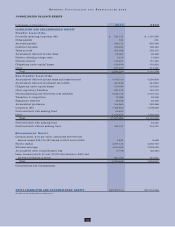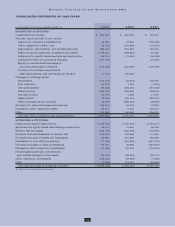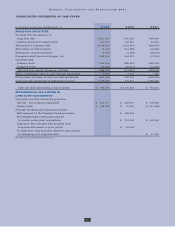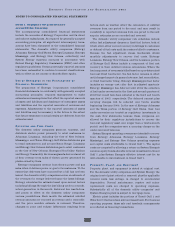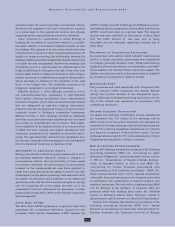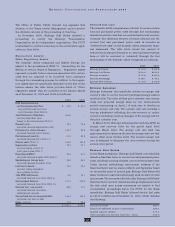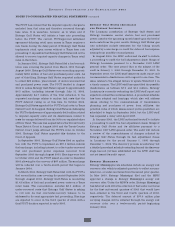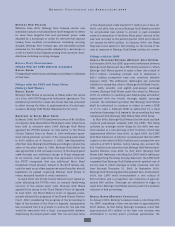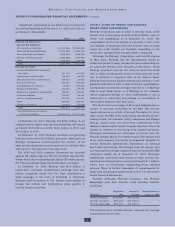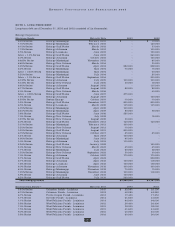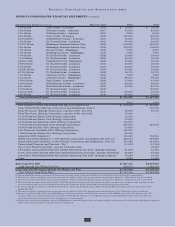Entergy 2003 Annual Report Download - page 62
Download and view the complete annual report
Please find page 62 of the 2003 Entergy annual report below. You can navigate through the pages in the report by either clicking on the pages listed below, or by using the keyword search tool below to find specific information within the annual report.
60
ENTERGY CORPORATION AND SUBSIDIARIES 2003
or part of its operations should report that event in its
financial statements. In general, SFAS 101 requires that the
enterprise report the discontinuation of the application of
SFAS 71 by eliminating from its balance sheet all regulatory
assets and liabilities related to the applicable segment.
Additionally, if it is determined that a regulated enterprise
is no longer recovering all of its costs and therefore no
longer qualifies for SFAS 71 accounting, it is possible that
an impairment may exist that could require further write-
offs of plant assets.
Emerging Issues Task Force (EITF) 97-4: “Deregulation
of the Pricing of Electricity - Issues Related to the
Application of FASB Statements No. 71 and 101” specifies
that SFAS 71 should be discontinued at a date no later than
when the effects of a transition to competition plan for all
or a portion of the entity subject to such plan are reasonably
determinable. Additionally, EITF 97-4 promulgates that
regulatory assets to be recovered through cash flows
derived from another portion of the entity that continues to
apply SFAS 71 should not be written off; rather, they should
be considered regulatory assets of the segment that will
continue to apply SFAS 71.
See Note 2 to the consolidated financial statements for
discussion of transition to competition activity in the retail
regulatory jurisdictions served by the domestic utility
companies. Only Texas has a currently enacted retail open
access law, but Entergy believes that significant issues
remain to be addressed by regulators, and the enacted law
does not provide sufficient detail to reasonably determine
the impact on Entergy Gulf States’ regulated operations.
CASH AND CASH EQUIVALENTS
Entergy considers all unrestricted highly liquid debt
instruments with an original or remaining maturity of
three months or less at date of purchase to be cash equivalents.
Investments with original maturities of more than three
months are classified as other temporary investments on
the balance sheet.
INVESTMENTS
Entergy applies the provisions of SFAS 115, “Accounting
for Investments for Certain Debt and Equity Securities,” in
accounting for investments in decommissioning trust
funds. As a result, Entergy records the decommissioning
trust funds at their fair value on the consolidated balance
sheet. As of December 31, 2003 and 2002, the fair value of
the securities held in such funds differs from the amounts
deposited plus the earnings on the deposits by $94 million
and ($24) million, respectively. Because of the ability of the
domestic utility companies and System Energy to recover
decommissioning costs in rates and in accordance with the
regulatory treatment for decommissioning trust funds, the
domestic utility companies and System Energy have recorded
an offsetting amount of unrealized gains/(losses) on investment
securities in other regulatory liabilities/assets. Prior to the
implementation of SFAS 143, the offsetting amount of
unrealized gains/(losses) on investment securities was
recorded in accumulated depreciation for Entergy
Arkansas, Entergy Gulf States (for the regulated portion of
River Bend), and for Entergy Louisiana. For the non-
regulated portion of River Bend, Entergy Gulf States has
recorded an offsetting amount of unrealized gains/(losses)
in other deferred credits. Decommissioning trust funds for
Pilgrim, Indian Point 2, and Vermont Yankee do not receive
regulatory treatment. Accordingly, unrealized gains and
losses recorded on the assets in these trust funds are
recognized in the accumulated other income component of
shareholders’ equity because these assets are classified as
available for sale.
EQUITY METHOD INVESTEES
Entergy owns investments that are accounted for under the
equity method of accounting because Entergy’s ownership
level results in significant influence, but not control, over
the investee and its operations. Entergy records its share of
earnings or losses of the investee based on the change
during the period in the estimated liquidation value of the
investment, assuming that the investee’s assets were to be
liquidated at book value. The equity earnings for Entergy-
Koch, LP recorded by Entergy are dictated by the terms of
the partnership agreement in accordance with the
hypothetical liquidation at book value (HLBV) method. In
accordance with the HLBV method, earnings are allocated
to members based on what each partner would receive from
their capital account if, hypothetically, liquidation were to
occur at the balance sheet date and amounts distributed
were based on recorded book values. Entergy discontinues
the recognition of losses on equity investments when its
share of losses equals or exceeds its carrying amount of
investee plus any advances made or commitments to
provide additional financial support. See Note 13 to the
consolidated financial statements for additional information
regarding Entergy’s equity method investments.
DERIVATIVE FINANCIAL INSTRUMENTS AND
COMMODITY DERIVATIVES
Entergy implemented SFAS 133, “Accounting for Derivative
Instruments and Hedging Activities” on January 1, 2001.
The statement requires that all derivatives be recognized in
the balance sheet, either as assets or liabilities, at fair value,
unless they meet the normal purchase, normal sales criteria.
The changes in the fair value of recognized derivatives are
recorded each period in current earnings or other compre-
hensive income, depending on whether a derivative is
designated as part of a hedge transaction and the type of
hedge transaction.
Contracts for commodities that will be delivered in quantities
expected to be used or sold in the ordinary course of busi-
ness, including certain purchases and sales of power and
fuel, are not classified as derivatives. These contracts are
NOTES TO CONSOLIDATED FINANCIAL STATEMENTS
continued





